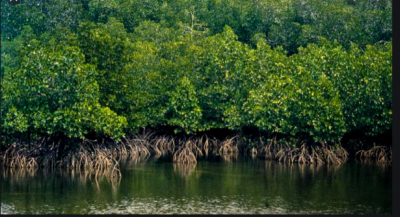
Mangroves are bushes or trees that grow in thick clusters along sea coasts and riverbanks.
Their roots stick out of the mud in thick tangles and prevent the waves from washing away the sand (or dirt) from the coastline Sundarbans in Bangladesh and India is the world’s largest single tract of mangroves.
Where Are Mangroves Found?
Mangroves grow in sheltered tropical and subtropical coastal areas across the globe. In general, this is an area between latitudes of 25 degrees north and 25 degrees south, however, geographical limits are highly variable depending upon the area of the world and local climates. In Eastern Australia, the mangrove Avicennia marina can grow as far south as 38 degrees and Avicennia germinans can grow as far north as 32 degrees in the Atlantic. A major restriction for where mangroves can live is temperature. The cooler temperatures of northern temperate regions prove too much for the mangroves. A fluctuation of ten degrees in a short period of time is enough stress to damage the plant and freezing temperatures for even a few hours can kill some mangrove species. However, rising temperatures and sea level due to climate change are allowing mangroves to expand their ranges farther away from the equator and encroach on temperate wetlands, like salt marshes. Also, on some isolated tropical islands, such as Hawaii and Tahiti, mangroves are not native and are sometimes considered invasive species.
Growth and Reproduction
Life by the ocean has its perks—for mangroves, proximity to the waves and tides helps with reproduction.
For most plants, the seeds remain dormant until after they are dispersed to a favorable environment. Not mangroves. Mangrove offspring begin to grow while still attached to their parent. This type of plant reproduction is called vivipary. After mangrove flowers are pollinated the plants produce seeds that immediately begin to germinate into seedlings. The little seedlings, called propagules, then fall off the tree, and can be swept away by the ocean current. Depending upon the species, propagules will float for a number of days before becoming waterlogged and sinking to the muddy bottom, where they lodge in the soil. Propagules of Rhizophora are able to grow over a year after they are released from their parent tree, while the white mangrove, Laguncularia racemosa, floats for up to 24 days, though it starts losing its ability to take root after eight. The flotation time allows for the propagules to vacate the area where their parent grows and avoid competition with an already established mangrove.
Mangroves as Ecosystems
Mangroves are among the most productive and biologically complex ecosystems on Earth. They cover between roughly 53,000 and 77,000 square miles (138,000 and 200,000 square km) globally, acting as a bridge connecting the land and sea. Though most will be less than a couple miles thick along the coastline, in some areas of the world they are massive aquatic forests. The Sundarbans Forest, a UNESCO World Heritage site at the mouth of the Ganges, Brahmaputra, and Megha Rivers in the Bay of Bengal fronting India and Bangladesh, is a network of muddy islands and waterways that extends roughly 3,860 square miles (10,000 square km), two times the size of the state of Delaware.
Credit : Ocean find your blues
Picture Credit : Google




